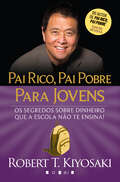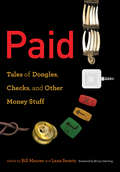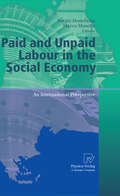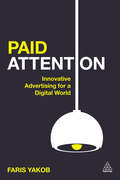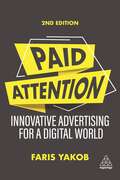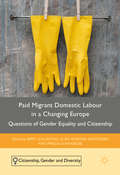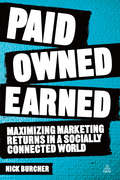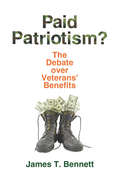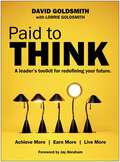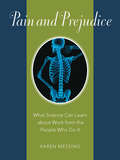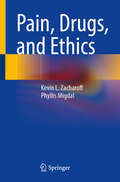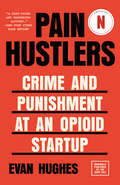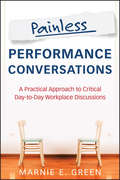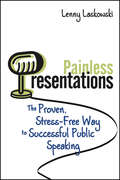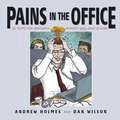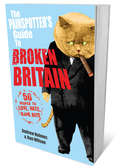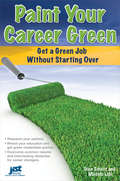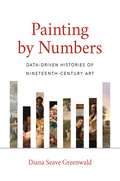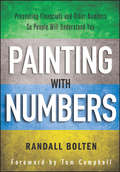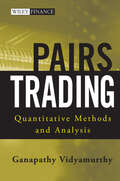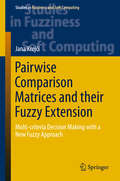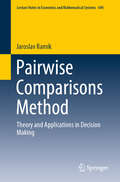- Table View
- List View
Pai Rico, Pai Pobre Para Jovens: Edição Revista
by Robert T. KiyosakiOs segredos sobre dinheiro que a escola não te ensina O CAMINHO PARA A TUA LIBERDADE FINANCEIRA COMEÇA AQUI Sentes que muito do que aprendes nas aulas nada tem que ver com a tua vida? Sentes que a escola não te está a preparar para a vida real? Sim? Então este livro é para ti. Quando jovem, Robert Kiyosaki não era propriamente o melhor aluno. Isso não acontecia por falta de inteligência; ele simplesmente não aprendia consoante as expetativas dos seus professores. Mas a sua vida mudou quando conheceu um mentor que lhe ensinou tudo sobre dinheiro e investimentos. Teve tanto êxito que se reformou ainda novo. Acessível e recheado de conselhos, Pai Rico, Pai Pobre Para Jovens faz mais do que partilhar uma incrível história pessoal. Mostra-te como fazer escolhas hoje que te permitirão gerar mais dinheiro, ensinando-te:A falar a língua do dinheiro. As diferentes formas de pôr o dinheiro a trabalhar para ti. Dicas para o êxito - incluindo "trabalhar para aprender, não para ganhar dinheiro". A dominar as ferramentas fundamentais para fazer o dinheiro crescer. Este livro é a arma secreta que te vai permitir ganhar a liberdade para gerares riqueza. "A principal razão pela qual as pessoas enfrentam dificuldades financeiras é porque passaram anos na escola, mas nada aprenderam sobre dinheiro. O resultado é que aprendem a trabalhar por dinheiro… mas nunca aprendem a fazer com que o dinheiro trabalhe para elas." Robert T. Kiyosaki
Paid: Tales of Dongles, Checks, and Other Money Stuff (Infrastructures)
by Bill Maurer Lana SwartzStories about objects left in the wake of transactions, from cryptocurrencies to leaf-imprinted banknotes to records kept with knotted string.Museums are full of the coins, notes, beads, shells, stones, and other objects people have exchanged for millennia. But what about the debris, the things that allow a transaction to take place and are left in its wake? How would a museum go about curating our scrawls on electronic keypads, the receipts wadded in our wallets, that vast information infrastructure that runs the card networks? This book is a catalog for a museum exhibition that never happened. It offers a series of short essays, paired with striking images, on these often ephemeral, invisible, or unnoticed transactional objects—money stuff.Although we've been told for years that we're heading toward total cashlessness, payment is increasingly dependent on things. Consider, for example, the dongle, a clever gizmo that processes card payments by turning information from a card's magnetic stripe into audio information that can be read by a smart phone's headphone jack. Or dogecoin, a meme of a smiling, bewildered dog's interior monologue that fueled a virtual currency similar to Bitcoin. Or go further back and contemplate the paper currency printed with leaves by Benjamin Franklin to foil counterfeiters, or khipu, Incan records kept in knotted string.Paid's authors describe these payment-adjacent objects so engagingly that for a moment, financial leftovers seem more interesting than finance. Paid encourages us to take a moment to look at the nuts and bolts of our everyday transactions by looking at the stuff that surrounds them.ContributorsBernardo Bátiz-Lazo, Maria Bezaitis, Finn Brunton, Lynn H. Gamble, David Graeber, Jane I. Guyer, Keith Hart, Sarah Jeong, Alexandra Lippman, Julien Mailland, Scott Mainwaring, Bill Maurer, Taylor C. Nelms, Rachel O'Dwyer, Michael Palm, Lisa Servon, David L. Stearns, Bruce Sterling, Lana Swartz, Whitney Anne Trettien, Gary Urton
Paid and Unpaid Labour in the Social Economy
by Sergio Destefanis Marco MusellaThe book provides an up-to-date analytical and empirical treatment of some important interactions between paid and unpaid labour and the social economy. The emphasis on the motivations for paid and unpaid labour, and on how these factors contribute to efficiently providing social services, gives a clear empirical counterpart to the concept of social economy. The book begins with a theoretical perspective on the development and characteristics of paid and unpaid labour in social services. Several empirical analyses, largely using novel data sets, are then provided about these phenomena in Italy, a country which has drawn broad international attention in this field, as well as in other European countries and in the US. Topics of particular interest include: preferences regarding and satisfaction with paid and unpaid labour; ownership structure and risk; ownership structure, remuneration and incentives for paid labour; characteristics of volunteer labour and its relationship with social capital endowment across Italian regions; and a comparative analysis of labour in the nonprofit sector across Europe.
Paid Attention
by Faris YakobAs ever, the onus is on brands to find compelling ways to earn the attention of the consumer. Yet content scarcity has given way to overload, fixed channels have dissolved into fluid networks, and audiences have become participants in consumer-driven conversations. This shift requires a new course of action for brands; it demands new marketing imperatives. Paid Attention is a guide to modern advertising ideas: what they are, why they are evolving and how to have them. Spanning communication theory, neuroscience, creativity and innovation, media history, branding and emerging technologies, it explores the strategic creation process and how to package ideas to attract the most attention in the advertising industry. Packed with real-world examples of advertising campaigns for companies including Sony, Red Bull, HP and many more, Paid Attention provides a robust model for influencing human behaviour. Referencing a wide body of theory and praxis, from behavioural economics and sociology to technology and even science fiction, Faris Yakob maps advertising onto a wider analysis of culture. Containing practical advertising and branding templates, including a new advertising planning toolkit, it is ideal for students and practitioners looking to get noticed in today's cluttered marketplace.
Paid Attention: Innovative Advertising for a Digital World
by Faris YakobThe advertising attention marketplace is a confusing and vast playing field where the rules have changed drastically over the last decade. Make yourself heard and win the attention of your target audience with the new edition of this ultimate guide.Paid Attention delivers new and innovative insights into advertising ideas: what they are, why they are evolving and how to use them in day to day strategy to ensure commercial stability within a changing digital landscape. Packed with real-world examples of advertising campaigns such as Google, Sony and Old Spice, it provides a robust model for influencing human behaviour and toolkits that offer best practice on brand behaviour and effective communication.This second edition includes two new chapters exploring the latest evidence about attention spans and trends in online advertising, as well as new case studies on compelling brand ideas. In a world where being a consumer is confusing, learn to take control of the situation and make yourself heard in today's crowded attention marketplace.
Paid Migrant Domestic Labour in a Changing Europe
by Priscilla Ringrose Guro Korsnes Korsnes Kristensen Berit GullikstadThis book analyses the changing face of work, gender equality and citizenship in Europe. Drawing on in-depth research conducted in nine different countries, it focuses on the discourses, social relations and political processes that surround paid domestic labour. In doing so, it rethinks the vital relationship between this kind of employment, the formal and informal citizenship of migrant workers and their employers, and the cultural and political value of gender equality. Approaching these as fluid, complex and interrelated phenomena that change according to local context, it will appeal to sociologists, political scientists, geographers, anthropologists and gender studies scholars.
Paid, Owned, Earned
by Nick BurcherThe complexity of media that now sees multiple channels accessed through multiple devices has created major challenges for today's marketing and advertising professionals. Consumer time is split between TVs, laptops, iPads, X-Boxes and smartphones, with traditional media, websites, videos, social networks and apps all competing for attention, meaning it's difficult for brands to decide how best to reach and engage their audiences. Paid, Owned, Earned defines the constituents of each area of 'paid', 'owned' and 'earned' media and shows how they are linked together. It proposes a blueprint for how to think and navigate across this space using a framework made up of key elements such as communities and content, social media optimisation, seeding and viral distribution, broadcast mass media, social performance media and measurement.
Paid Patriotism?: The Debate over Veterans' Benefits
by James T. BennettWhat does a nation owe its military veterans? Gratitude, esteem, land grants, medical care, pensions, higher education? Or is serving in the armed forces of one’s country an obligation to be undertaken without any expectation of compensation? If veterans are to receive government aid, should a distinction be made between those who served in wartime or faced enemy fire and those who saw neither war nor combat? These questions have been answered in varying ways by the American people and their elected representatives since the Revolutionary War. Paid Patriotism? explores the genesis and growth of soldiers’ pensions throughout the nineteenth century, the Bonus experiment after the First World War, the passage and consequences of the GI Bill of Rights, the growth of the nation’s system of veterans’ hospitals, the evolution of veterans’ programs during the Cold War and Vietnam, the post-9/11 GI Bill, and contemporary scandals and reform efforts within the veterans’ bureaucracy, from its promotion to a cabinet department to wrongdoing in the Veterans Health Administration. James T. Bennett examines the complex and politically charged history and heated present-day debate of what the late columnist William Safire called the “most sacred cow” in Washington: the veterans’ bureaucracy. In the end, the United States and its citizens owe veterans a debt. But how has and how should that debt be honored—and at what cost?
Paid to Think: A Leader's Toolkit for Redefining Your Future
by David GoldsmithHave you ever thought about the fact that a craftsman has more and better tools to solve challenges on the job than the leader of a business or organization does? Leadership "tools" are usually defined as computers, spreadsheets, data, and even experience, but in reality, leaders need thinking tools that are hard to come by, so they find themselves hunting and pecking for answers in books, at seminars, through on-the-job training programs, from mentors, and at business schools, and still, they're left with gaps. Surely, most leaders are good at what they do, but the daily challenges of their jobs, like accelerating growth, increasing productivity, driving innovation, doing more with less, and balancing work with life don't come with some sort of leadership toolkit...until now. In Paid to Think, international consultant David Goldsmith presents his groundbreaking approach to leadership and management based on research revealing the twelve specific activities that all leaders perform on a daily basis, and he provides you with each activity's accompanying tools and instructions proven to boost your performance and that of your entire organization. Take the uncertainty out of everyday leading, convert ideas to realities, and maximize your intellectual value. Learn how decision makers at some of the world's most successful organizations have already used Paid to Think's universal and easily transferable tools—regardless of their industries, sectors, geographic locations, or management levels—as their greatest advantages in achieving more, earning more, and living more.
Pain and Prejudice: What Science Can Learn About Work From The People Who Do It
by Dr Karen MessingIn 1978, when workers at a nearby phosphate refinery learned that the ore they processed was contaminated with radioactive dust, Karen Messing, then a new professor of molecular genetics, was called in to help. Unsure of what to do with her discovery that exposure to the radiation was harming the workers and their families, Messing contacted senior colleagues but they wouldn’t help. Neither the refinery company nor the scientific community was interested in the scary results of her chromosome studies. Over the next decades Messing encountered many more cases of workers around the world—factory workers, cleaners, checkout clerks, bank tellers, food servers, nurses, teachers—suffering and in pain without any help from the very scientists and occupational health experts whose work was supposed to make their lives easier. Arguing that rules for scientific practice can make it hard to see what really makes workers sick, in Pain and Prejudice Messing tells the story of how she went from looking at test tubes to listening to workers.
Pain, Drugs, and Ethics
by Kevin L. Zacharoff Phyllis MigdalPain remains one of the most common reasons that people seek medical attention in the United States today. One of the ways health care providers responded to pain being designated the “5th vital sign” was with their prescription pads. In order to respond to subjective pain-ratings, opioid analgesics began to be prescribed more liberally than in the past, presumably with the intention of responding to information about pain-related complaints now captured in routine assessments. This was in concert with several other circumstances, including the appearance and promulgation of “pill mills”, questionable marketing practices by opioid manufacturers, and increasing rates of abuse, misuse, and addiction related to opioid analgesics. All this taking place in an environment of tremendous educational deficits related to pain, its assessment and treatment, and risks of aberrant drug-related behaviors. There is now a challenge to balancing the safe, compassionate, and effective treatment of chronic pain against serious negative outcomes associated with the increased abuse and misuse of these medications. With overdose death rates increasing, tensions running high, a multitude of political and regulatory involvement, and “knee-jerk” reactiveness, it seems as if the only thing being forgotten are the needs of chronic pain patients and the core ethical principles intended to help clinicians maintain the highest ethical standards of care. This book delves into this background and offers the context of professionalism and ethics taught to most healthcare professionals today, and describes how these principles can help to maximize safety, efficacy, and compassionate pain care, regardless of the direction the “opioid pendulum” is swinging. A framework is provided for clinicians to rely on best practices in managing acute, subacute, and chronic pain. The goal is to help clinicians provide patients with pain the most reliable, contextual, and ethical pain care possible. Pain, Drugs, and Ethics is written for the multiple disciplines involved in managing patients with pain today.
Pain Hustlers: Crime and Punishment at an Opioid Startup Originally published as The Hard Sell
by Evan HughesThe inside story of a band of entrepreneurial upstarts who made millions selling painkillers—until their scheme unraveled, putting them at the center of a landmark criminal trial. • SOON TO BE THE MAJOR MOTION PICTURE PAIN HUSTLERS STARRING EMILY BLUNT AND CHRIS EVANS "Unfolds with the velocity and verve of a Scorsese film…A tour de force."—Patrick Radden Keefe, New York Times bestselling author of Empire of Pain and Say Nothing John Kapoor had already amassed a small fortune in pharmaceuticals when he founded Insys Therapeutics. It was the early 2000s, a boom time for painkillers, and he developed a novel formulation of fentanyl, the most potent opioid on the market. Kapoor, a brilliant immigrant scientist with relentless business instincts, was eager to make the most of his innovation. He gathered around him an ambitious group of young lieutenants. His head of sales—an unstable and unmanageable leader, but a genius of persuasion—built a team willing to pull every lever to close a sale, going so far as to recruit an exotic dancer ready to scrape her way up. They zeroed in on the eccentric and suspect doctors receptive to their methods. Employees at headquarters did their part by deceiving insurance companies. The drug was a niche product, approved only for cancer patients in dire condition, but the company&’s leadership pushed it more widely, and together they turned Insys into a Wall Street sensation. But several insiders reached their breaking point and blew the whistle. They sparked a sprawling investigation that would lead to a dramatic courtroom battle, breaking new ground in the government&’s fight to hold the drug industry accountable in the spread of addictive opioids. In Pain Hustlers, National Magazine Award–finalist Evan Hughes lays bare the pharma playbook. He draws on unprecedented access to insiders of the Insys saga, from top executives to foot soldiers, from the patients and staff of far-flung clinics to the Boston investigators who treated the case as a drug-trafficking conspiracy, flipping cooperators and closing in on the key players. With colorful characters and true suspense, Pain Hustlers offers a bracing look not just at Insys, but at how opioids are sold at the point they first enter the national bloodstream—in the doctor&’s office.
Painless Performance Conversations
by Marnie E. GreenActionable communication and management strategies for tackling difficult workplace discussions Delivering the uncomfortable news that an employee is not stacking up can be stressful, and managers often have difficulties finding the right words to get their message across. Painless Performance Conversations presents actionable and practical communication and management strategies for any manager looking to effectively influence employee performance. Learn how to focus these conversations for maximum impact on performance, crystallize expectations for what success looks like, and engage employees in solution-finding.Presenting four key mindsets and an easy to use conversation model, this book offers the tangible solutions managers need to tackle critical workplace discussions with poise and professionalism, as well as the tools needed to stay focused in otherwise difficult conversations. Eliminates the pain and fear that leads to procrastination of tough workplace conversations. Reduces the harmful impacts of judgment in performance conversationHelps managers create a culture of ownership and accountabilityAuthor Marnie E. Green is a featured blogger for Jobing.com and shares her popular and practical management perspectives in keynotes, webinars, and workshops with thousands of leaders in organizations worldwidePainless Performance Conversations will help you to lead performance-related conversations with confidence and create a culture of workplace accountability.
Painless Presentations: The Proven, Stress-Free Way to Successful Public Speaking
by Lenny LaskowskiA simple road map to the world of professional presentations What happens when you're asked to give a speech, professionally or personally? If you get nervous, start sweating, and hope it's all just a bad dream then you aren't alone, but you need help. Painless Presentations proves that speaking doesn't have to be painful, or even stressful. A speech is a means to giving great, helpful material to an audience and the speaker is the vehicle to achieve that goal. This simple-to-read book guides those just beginning their journey into the world of speaking. Painless Presentations teaches the "Dozen Deadly Dangers" to avoid and much more. Explains how to gather information and materials Details the structure of a presentation Describes uses of visual aids and vocal variety Demonstrates how to handle questions Painless Presentations offers wisdom derived from Lenny Laskowski's thirty-five-year speaking career, delivering more than 2,700 programs to clients in over 178 countries. It will give you no-sweat tips for delivering speeches that win over your audiences every time and teaches you that giving speeches doesn't have to be painful.
Pains in the Office
by Andrew Holmes Daniel WilsonWhat could be worse than being stuck in an office all day? Meetings, deadlines. . . colleagues. Surely no torture can crush the spirit so completely as prolonged exposure to these people. You?ve faked phone calls to avoid them. You?ve hidden in toilet cubicles until they?ve gone away. At last there?s an effective way to fight back. Pains in the Office will help you identify, shun and plan your revenge on the 50 worst types of people you meet at work. Your job may be awful, you may hate your colleagues with a passion, but here at least is a happy place to retreat into. This is your comfort blanket, hidey-hole and fire escape all rolled into one. Pains in the Office is guaranteed to become as indispensable to the office worker as cigarette breaks and free stationery. It?s the perfect antidote to nightmarish co-workers everywhere!
The Painspotter's Guide to Broken Britain
by Andrew HolmesWelcome to Broken Britain!MPs are blaming 'The System' for their thieving behaviour. Bankers have burnt through more cash than President Mugabe and still been bailed out. Britain is Broke. Only one thing's going to sort this mess out - some good old-fashioned finger pointing. It's time to take revenge... Painspotting style.Let the Painspotting commence!This book is more effective than Prozac and cheaper than therapy. You may be angry, you may be mad, you may even be institutionalised, but put the baseball bat away, hang up your lynching rope, and let the Painspotting commence!50 of the bestLove them, hate them, blame them, rate them: The Painspotter's Guide to Broken Britain introduces the 50 most frightful characters you'll meet in a financial crisis, so prepare to laugh out loud at the Frightened Fat Cat, the Miserable Middle Class, the Self-help Saddo and many more.
Paint-Pen, Inc.
by Michael J. RobertsPresents the background and some details on a possible acquisition opportunity--a manufacturer of ballpoint paint pens for the hobby and crafts industry. Forces students to peel the layers of this initially unattractive opportunity to find potential sources of value. A rewritten version of an earlier case.
Paint Your Career Green
by Michele Lobl Stan SchattA roadmap for people who want to avoid starting over or taking a severe pay cut when they change careers to become part of a growing green industry. Readers will learn about green certificate programs that offer retraining in a short timeframe.
Painting by Numbers: Data-Driven Histories of Nineteenth-Century Art
by Diana Seave GreenwaldA pathbreaking history of art that uses digital research and economic tools to reveal enduring inequities in the formation of the art historical canonPainting by Numbers presents a groundbreaking blend of art historical and social scientific methods to chart, for the first time, the sheer scale of nineteenth-century artistic production. With new quantitative evidence for more than five hundred thousand works of art, Diana Seave Greenwald provides fresh insights into the nineteenth century, and the extent to which art historians have focused on a limited—and potentially biased—sample of artwork from that time. She addresses long-standing questions about the effects of industrialization, gender, and empire on the art world, and she models more expansive approaches for studying art history in the age of the digital humanities.Examining art in France, the United States, and the United Kingdom, Greenwald features datasets created from indices and exhibition catalogs that—to date—have been used primarily as finding aids. From this body of information, she reveals the importance of access to the countryside for painters showing images of nature at the Paris Salon, the ways in which time-consuming domestic responsibilities pushed women artists in the United States to work in lower-prestige genres, and how images of empire were largely absent from the walls of London’s Royal Academy at the height of British imperial power. Ultimately, Greenwald considers how many works may have been excluded from art historical inquiry and shows how data can help reintegrate them into the history of art, even after such pieces have disappeared or faded into obscurity.Upending traditional perspectives on the art historical canon, Painting by Numbers offers an innovative look at the nineteenth-century art world and its legacy.
Painting with Numbers
by Tom Campbell Randall BoltenLearn how to communicate better with numbersWhether you are distributing a report or giving a presentation, you have a lot of numbers to present and only a few minutes to get your point across. Your audience is busy and has a short attention span. Don't let an amateur presentation bog you down, confuse your audience, and damage your credibility. Instead, learn how to present numerical information effectively--in the same way you learned how to speak or write. With Painting with Numbers, you'll discover how to present numbers clearly and effectively so your ideas and your presentation shine.Use the Arabic numeral system to your advantage master the use of layout and visual effects to communicate powerfullyUnderstand how audiences process your information and how that affects your "personal brand image"Learn how to be perceived as a professional who truly understands the business concepts and issues underlying your numbersUse software tools, including Excel, PowerPoint, and graphs, efficiently and to drive home your pointAuthor Randall Bolten shares his decades of experience as a senior finance executive distilling complicated information into clear presentations, to help you make your numerical information more comprehensible, meaningful, and accessible. Painting with Numbers is brimming with hands-on advice, techniques, tools, rules, and guidelines for producing clear, attractive, and effective quantation (the word the author has coined for the skill of presenting numbers).
Pairs Trading
by Ganapathy VidyamurthyThe first in-depth analysis of pairs trading Pairs trading is a market-neutral strategy in its most simple form. The strategy involves being long (or bullish) one asset and short (or bearish) another. If properly performed, the investor will gain if the market rises or falls. Pairs Trading reveals the secrets of this rigorous quantitative analysis program to provide individuals and investment houses with the tools they need to successfully implement and profit from this proven trading methodology. Pairs Trading contains specific and tested formulas for identifying and investing in pairs, and answers important questions such as what ratio should be used to construct the pairs properly. Ganapathy Vidyamurthy (Stamford, CT) is currently a quantitative software analyst and developer at a major New York City hedge fund.
Pairwise
by Annelena Lobb Jose B. AlvarezPairwise discusses the strategic approach of a company aiming to "snackify" fruits and vegetables by using CRISPR-Cas9 gene editing to create nutritious, bite-sized foods that could compete with packaged snacks. The company is confronting a number of challenges, including distinguishing their approach from that of GMO foods, which had a mixed public reception.
Pairwise Comparison Matrices and their Fuzzy Extension: Multi-criteria Decision Making With A New Fuzzy Approach (Studies in Fuzziness and Soft Computing #366)
by Jana KrejčíThis book offers the first comprehensive and critical literature review of fuzzy pairwise comparison methods derived from methods originally developed for crisp pairwise comparison matrices. It proposes new fuzzy extensions of these methods and provides a detailed study of the differences and analogies between all the reviewed methods, as well as a detailed description of their drawbacks, with the help of many numerical examples. In order to prevent the drawbacks related to the reviewed fuzzy pairwise comparison methods, the book introduces constrained fuzzy arithmetic in fuzzy extension of the pairwise comparison methods. It proposes new fuzzy pairwise comparison methods based on constrained fuzzy arithmetic and critically compares them with the reviewed methods. It describes the application of the newly developed methods to incomplete large-dimensional pairwise comparison matrices showcased in a real-life case study. Written for researchers, graduate and PhD students interested in multi-criteria decision making methods based on both crisp and fuzzy pairwise comparison matrices, this self-contained book offers an overview of cutting-edge research and all necessary information to understand the described tools and use them in real-world applications.
Pairwise Comparisons Method: Theory and Applications in Decision Making (Lecture Notes in Economics and Mathematical Systems #690)
by Jaroslav RamíkThis book examines relationships between pairwise comparisons matrices. It first provides an overview of the latest theories of pairwise comparisons in decision making, discussing the pairwise comparison matrix, a fundamental tool for further investigation, as a deterministic matrix with given elements. Subsequent chapters then investigate these matrices under uncertainty, as a matrix with vague elements (fuzzy and/or intuitionistic fuzzy ones), and also as random elements. The second part of the book describes the application of the theoretical results in the three most popular multicriteria decision-making methods: the Analytic Hierarchy Process (AHP), PROMETHEE and TOPSIS. This book appeals to scholars in areas such as decision theory, operations research, optimization theory, algebra, interval analysis and fuzzy sets.
